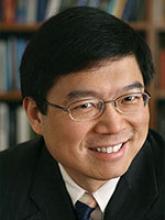World’s deepest-penetration and fastest optical cameras: photoacoustic tomography and compressed ultrafast photography
Date & Time:
Fri, 11/13/2020 - 2:00pmSpeaker:
Lihong WangJob title:
Bren Professor, Member of National Academy of EngineeringAffiliation:
California Institute of TechnologyLocation:
ZOOM: Register to be invitedAbstract:
We developed photoacoustic tomography (PAT) to peer deep into biological tissue. PAT provides in vivo omniscale functional, metabolic, molecular, and histologic imaging across the scales of organelles through organisms. We also developed compressed ultrafast photography (CUP) to record 70 trillion frames per second, 10 orders of magnitude faster than commercially available camera technologies. CUP can record the fastest phenomenon in nature, namely, light propagation, and can be slowed down for slower phenomena such as neural conduction.
PAT physically combines optical and ultrasonic waves. Conventional high-resolution optical imaging of scattering tissue is restricted to depths within the optical diffusion limit (~1 mm). PAT beats this limit and provides deep penetration at high ultrasonic resolution and high optical contrast by sensing molecules. Broad applications include early-cancer detection and brain imaging. The annual conference on PAT has become the largest in SPIE's 20,000-attendee Photonics West since 2010.
CUP can image with a single exposure transient events occurring on a time scale down to 10s of femtoseconds. Akin to traditional photography, CUP is receive-only—avoiding specialized active illumination required by other single-shot ultrafast imagers. CUP can be coupled with front optics ranging from microscopes to telescopes for widespread applications in both fundamental and applied sciences, ranging from biology to cosmophysics.

Biography:
Dr. Lihong Wang earned his Ph.D. degree at Rice University, Houston, Texas under the tutelage of Robert Curl, Richard Smalley, and Frank Tittel. He is Bren Professor of Medical Engineering and Electrical Engineering at California Institute of Technology. His book entitled “Biomedical Optics: Principles and Imaging,” one of the first textbooks in the field, won the 2010 Joseph W. Goodman Book Writing Award. He also edited the first book on photoacoustic tomography. He has published 540 peer-reviewed articles in journals, including Nature (Cover story), Science, PNAS, and PRL, and has delivered 540 keynote, plenary, or invited talks. His Google Scholar h-index and citations have reached 137 and 78,000, respectively. His laboratory was the first to report in vivo photoacoustic tomography, functional photoacoustic tomography, 3D photoacoustic microscopy, photoacoustic endoscopy, photoacoustic reporter gene imaging, the photoacoustic Doppler effect, the universal photoacoustic reconstruction algorithm, microwave-induced thermoacoustic tomography, ultrasound-modulated optical tomography, time-reversed ultrasonically encoded optical focusing, nonlinear photoacoustic wavefront shaping, compressed ultrafast photography (70 trillion frames/s, world's fastest real-time camera), Mueller-matrix optical coherence tomography, and optical coherence computed tomography. Photoacoustic imaging broke through the long-standing diffusion limit on the penetration of optical imaging, providing the only technology for noninvasive multiscale biochemical, functional, and molecular imaging from organelles to humans at high resolution. The technology has been commercialized by dozens of companies for both preclinical and clinical imaging. He chairs the annual conference on Photons plus Ultrasound, the largest conference at the annual 20,000-attendee Photonics West. He was the Editor-in-Chief of the Journal of Biomedical Optics. He received the NSF CAREER, NIH FIRST, NIH Director's Pioneer, NIH Director's Transformative Research, and NIH/NCI Outstanding Investigator awards. He also received the OSA C.E.K. Mees Medal, IEEE Technical Achievement Award, IEEE Biomedical Engineering Award, SPIE Britton Chance Biomedical Optics Award, IPPA Senior Prize, and OSA Michael S. Feld Biophotonics Award for “seminal contributions” to photoacoustic tomography and light-speed imaging. He is a Fellow of the AAAS, AIMBE, Electromagnetics Academy, IAMBE, IEEE, OSA, and SPIE as well as a Foreign Fellow of COS. An honorary doctorate was conferred on him by Lund University, Sweden. He was inducted into the National Academy of Engineering.
Series:
Distinguished Engineering Lecture
Department:
Biomedical Engineering